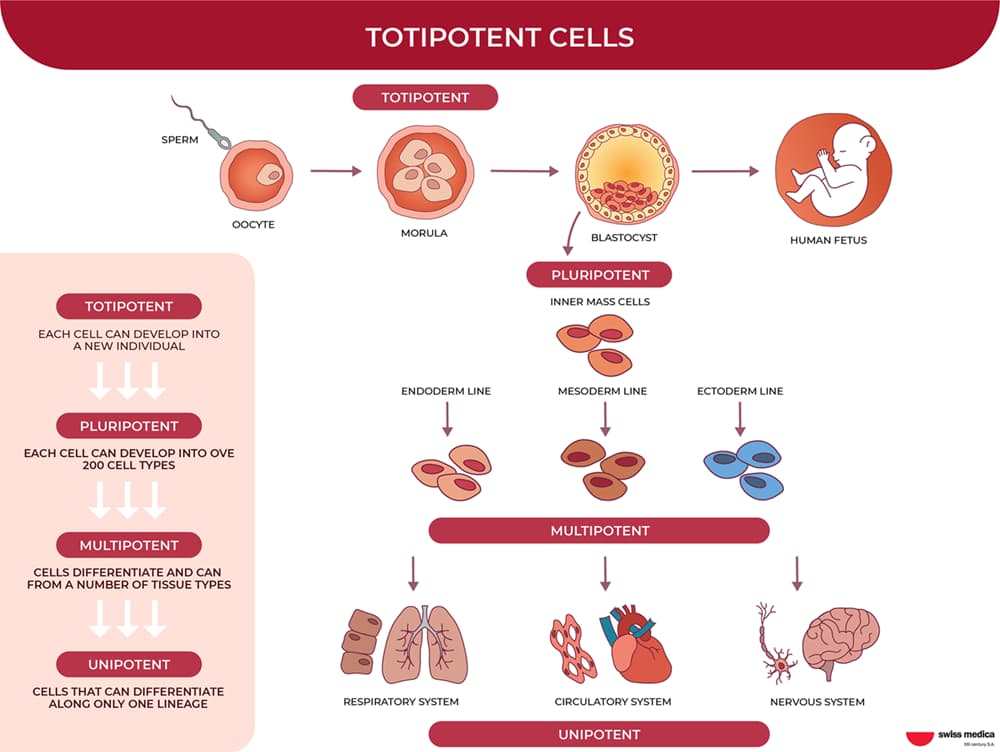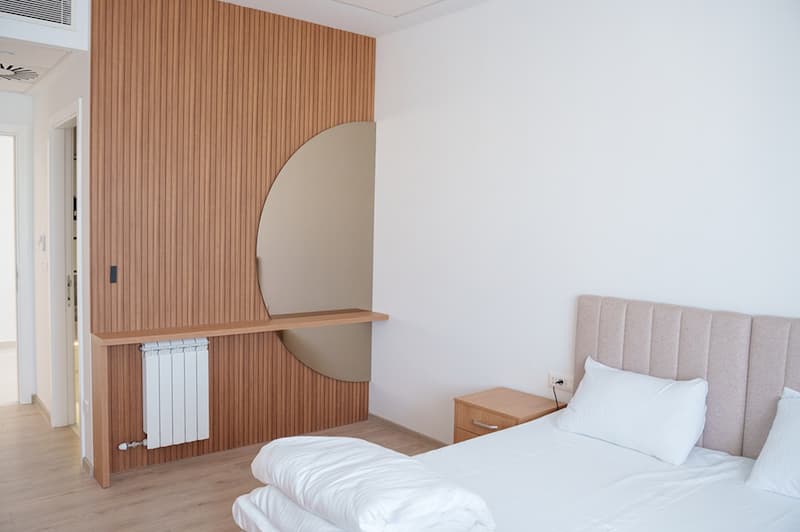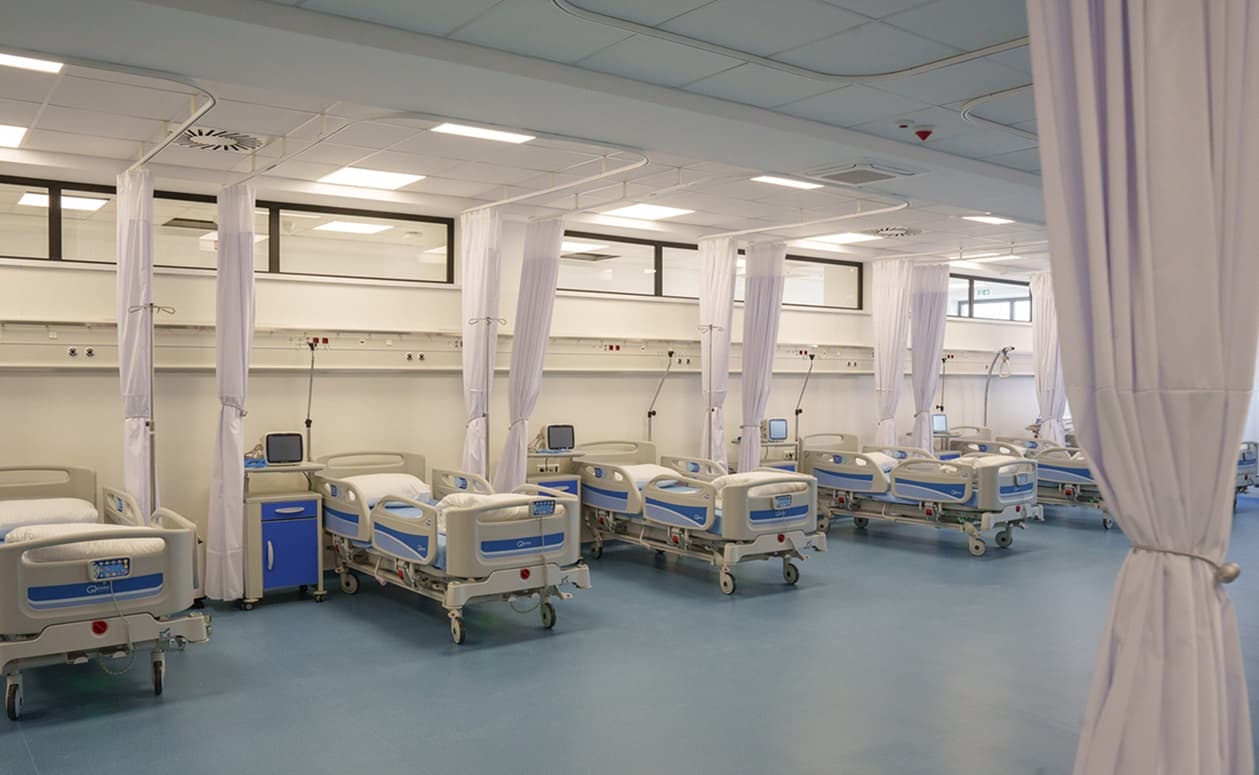Stem cell therapy is revolutionizing modern medicine by offering the potential to treat a wide range of complex diseases—a stark contrast to traditional approaches that often merely address symptoms. Rather than simply managing ailments, this innovative treatment taps into the body’s innate capacity to heal itself, promoting natural regeneration at the cellular level.
The benefits of stem cell therapy lie in enabling profound, lasting recovery—offering a chance for a full or partial recovery from chronic pain, injuries, while also helping manage symptoms and enhance daily function in individuals with neurodegenerative diseases.
In this article, we explore how stem cell therapy works, its potential applications, and the reasons it’s redefining the future of healthcare.
What Are Stem Cells?
Stem cells are the body’s natural repair system. They are the original building blocks from which other specialized cells—like those in your muscles, bones, nerves, or brain—are formed. Consider them a repair crew that helps other damaged tissues regenerate.
There are several types of stem cells, but at Swiss Medica, we focus exclusively on using adult mesenchymal stem cells (MSCs). The main advantage of using these stem cells in medicine is that they are not derived from embryos—adult stem cells are named simply to distinguish them from embryonic cells, which we do not use for both ethical and safety reasons.
The MSCs we use are:
- Ethically sourced without any involvement of embryos
- Clinically proven to be safe, with no risk of tumor formation
- Well-tolerated, with only mild, temporary side effects like a short-term rise in temperature
- Stable for long-term use, without worsening the patient’s condition
We mostly use donor-derived mesenchymal stem cells from placental tissue and umbilical cord tissue. In certain cases, when medically appropriate, we may also suggest the use of autologous MSCs—those taken from the patient’s own body—such as from bone marrow or adipose (fat) tissue, which is also known as stromal vascular fraction (SVF).
How Do Stem Cells Help the Body Heal?
Simply put, the main pros of stem cells, particularly MSCs, are that they travel to injured tissue, reduce inflammation, and promote cell proliferation. Here are the main advantages of stem cell work:
-
1
Release of active substances
Stem cells release biologically active substances, such as growth factors, that help repair damaged tissues and reduce inflammation. -
2
Improved blood circulation and collagen production
These growth factors stimulate better blood flow, enhance collagen production, and speed up tissue healing—supporting both medical and aesthetic recovery. -
3
Exosome and microvesicle activity
Stem cells release exosomes and microvesicles—tiny particles that carry proteins, RNA, and other signals to enhance tissue repair. -
4
Immune system modulation
One of the most important advantages of stem cell therapy is that it helps balance the immune system by reducing excessive inflammation and shifting it from a pro-inflammatory to an anti-inflammatory state. This is especially beneficial for autoimmune and chronic inflammatory conditions. -
5
Formation of new blood vessels
Stem cells support the growth of new blood vessels, improving oxygen and nutrient delivery to damaged areas, which enhances the overall healing process.
The advantages of using stem cells in medicine are evident in a wide range of conditions, including sports injuries and organ damage.

Why Do People Choose Stem Cell Therapy?
People turn to stem cell therapy when conventional treatments like medications or surgeries no longer help—or were never an option to begin with. It offers new options in complex conditions such as multiple sclerosis or Parkinson’s, where patients are often told, “You’ll just have to live with it.” For many, it’s a way to take action when all other paths seem closed.
In orthopedic and sports injuries, the main benefit of stem cells is that they can speed up recovery and help patients return to movement and daily life more quickly. Stem cell therapy aims to activate the body’s own healing potential—providing a chance to truly recover, not just cope.
Get a free online consultation
Find out if you are eligible for the treatment—schedule a free online consultation with our medical advisor. During the session, you will find all answers about possible benefits of using stem cells to treat your disease or condition.

Medical Advisor, Swiss Medica doctor
Does Stem Cell Therapy Heal or Just Reduce Symptoms?
One of the most common questions about the advantages of stem cell transplants is whether it truly heals the body or simply offers symptom relief. The truth is, it depends on the condition being treated and individual health history of a patient.
For certain issues, stem cells can help fully repair damaged tissue. This can be applied in the following cases:
- Cartilage damage
- Tendonitis
- Soft tissue injuries
In these situations, the main advantage of stem cell therapy is that it stimulates natural regeneration, helping the body heal and restore itself more effectively. Unlike painkillers or steroids, which only mask discomfort, stem cell therapy works at the source of the problem—supporting real, long-term improvement.
When it comes to more complex conditions such as Alzheimer’s disease or Parkinson’s, the benefits of stem cells may be more limited. In these cases, stem cells might:
- Delay the progression of symptoms
- Improve certain functions
- Support brain health on a cellular level
What Health Problems Can Stem Cell Therapy Help With?
The benefits of stem cells are recognized for a wide range of health issues—from chronic pain to complex neurological disorders. Here’s a closer look at the conditions it can help address.
Muscle and Joint Pain
Stem cells are widely used in treating conditions like osteoarthritis, tendinitis, and sports-related injuries. By reducing inflammation and encouraging cartilage regeneration, they help restore joint function and ease pain. At Swiss Medica, patients have been able to avoid invasive procedures like knee or hip replacements by choosing stem cell injections as a less disruptive alternative.
Benefits of stem cell treatment for musculoskeletal cases often include:
- Decreased joint inflammation
- Improved range of motion
- Reduced need for surgery
Autoimmune Conditions
The advantages of stem cell therapy for diabetes and other autoimmune conditions—such as multiple sclerosis (MS), lupus, and rheumatoid arthritis—include the ability to calm an overactive immune system that contributes to disease progression. They work by modulating immune responses and preventing the body from attacking its own healthy tissues. Key advantages of adult stem cells include:
- Fewer flare-ups and symptoms
- Reduced reliance on immunosuppressive drugs
- Long-term immune system balance
Nerve and Brain Disorders
The benefits of stem cells for Alzheimer’s and other neurological conditions—such as Parkinson’s disease, spinal cord injuries, and stroke recovery—include their potential to help repair damaged nerve cells and support brain function. Early clinical trials have shown patients’ improvements in:
- Motor control and coordination
- Memory and cognitive function
- Sensory and nerve response
Anti-Aging and Skin Rejuvenation
Stem cells don’t just treat diseases—they can work wonders for your appearance. The benefits of stem cells for skin include their ability to restore and revitalize skin tone. They stimulate collagen production, improve skin texture, and repair cells damaged by age or sun exposure. Cosmetic applications include:
- Smoothing wrinkles and fine lines
- Enhancing skin elasticity
- Improved joint mobility

Can Stem Cell Therapy Help Children with Autism?
In the context of autism spectrum disorder (ASD), the advantages of using stem cells are being investigated for their potential to alleviate some of the behavioral and neurological challenges that children face, such as issues with social interaction, hyperactivity, sleep disturbances, and even self-harming behaviors.
Some early studies and clinical observations suggest that advantages of mesenchymal stem cells may include managing certain symptoms of autism. These cells have unique properties that allow them to:
- Modulate the immune system by reducing inflammation and suppressing overactive immune responses.
- Lower oxidative stress in tissues, creating a healthier environment in the brain.
- Support the formation of new synapses and improve synaptic function, which may lead to better communication and cognitive function.
Why Stem Cell Therapy Is Different from Others
Unlike traditional treatments that focus on managing symptoms or replacing damaged parts through surgery, stem cell therapy works by activating the body’s own healing mechanisms. Below is a comparison of stem cell therapy with other common treatment methods:
| Treatment Type | Mechanism | Duration of Results | Invasiveness | Potential Risks |
| Stem Cell Therapy | Regenerates tissues, modulates immune system | Long-lasting, often several years | Minimally invasive | Mild, short-term side effects |
| Traditional Medications | Manages symptoms through chemical intervention | Variable, depends on the drug | Non-invasive to minimally invasive | Side effects like nausea, dizziness |
| Surgical Interventions | Repairs or replaces damaged tissues directly | Immediate results, long recovery | Highly invasive | Surgical complications, scarring |
| Physical Therapy | Improves mobility and strength through movement | Gradual improvement over time | Non-invasive | Risk of muscle strain or overexertion |
Let’s Sum Up: What Are the Main Benefits of Stem Cell Therapy?
Stem cell therapy is transforming the way we approach chronic conditions and injuries. Here are the key pros of stem cells that make them a promising option for many patients.
It Helps the Body Heal Naturally
The advantages of stem cell transplant include tissue repair, reduced inflammation, and fewer potential side effects—all without the need for synthetic drugs or implants.
Can Reduce Pain Without Surgery
Many patients suffering from chronic pain, such as back pain or arthritis, experience noticeable relief after stem cell therapy. Since it is minimally invasive, patients may avoid surgery altogether and benefit from shorter recovery times.
Here is an example. Our patient from Switzerland decided to choose stem cell therapy instead of the initially scheduled surgery for chronic knee and shoulder issues.
Key improvements after stem cell therapy:
- 80% symptom reduction: dramatic decrease in pain and inflammation in the knee and shoulder.
- Avoided surgery: successfully circumvented the need for planned surgical intervention.
- Restored physical abilities: regained strength and mobility to perform demanding exercises.
- Enhanced quality of life: improved daily functionality and return to an active, pain-free lifestyle.
Less Risk of Side Effects Compared to Drugs
The risk of rejection or allergic reactions is low. This makes stem cell therapy a safer alternative to medications, which can cause side effects like nausea or fatigue.
May Delay or Avoid Joint Replacements
Patients with arthritis or joint degeneration may benefit from stem cell injections, which can help regenerate cartilage and enhance joint function. In many cases, they can delay—or even eliminate—the need for joint replacement.
Helps Improve Quality of Life
Beyond pain relief, patients often report increased energy, reduced fatigue, better mobility, and improved overall function. These improvements can make daily tasks easier and restore a sense of independence, for example:
- Standing for longer periods without fatigue or discomfort
- Sitting comfortably without pain or stiffness
- Walking short and long distances without support
- Climbing stairs with greater ease
- Driving a car again with confidence and control
Regaining the ability to manage these simple, yet essential tasks often leads to improved confidence, emotional well-being, and a better overall quality of life.
Improvements After Stem Cell Therapy for Multiple Sclerosis
Diagnosed with multiple sclerosis in 2009, our patient initially struggled with unexplained falls and progressive weakness on the right side of his body, particularly in his leg—making walking increasingly difficult.
After undergoing his first stem cell therapy session at Swiss Medica, he experienced immediate benefits, including:
- Regaining the ability to walk without assistance
- Improved leg strength and mobility
- Ability to lift his right leg high—something UK doctors had deemed unlikely
Following a slight relapse three years later, his second and third treatments stabilized his condition, preventing further decline and enhancing:
- Walking ability
- Body balance and coordination
Personalization Based on Your Condition
Stem cell therapy isn’t a one-size-fits-all solution. At Swiss Medica, each treatment plan is tailored to the patient’s specific condition—whether it’s healing a sports injury, calming an autoimmune response, or treating degenerative joint disease.
Get a free online consultation
Our medical advisors are here to answer all your questions with no pressure—your health and comfort are our top priorities. Simply fill out the form below to book a free online consultation.

Medical Advisor, Swiss Medica doctor
Is Stem Cell Therapy Safe?
One of the primary advantages of using stem cells is that these therapies are considered safe. While the FDA has identified potential risks of using stem cells, these are mostly associated with hematopoietic (blood-forming) or embryonic stem cells. At Swiss Medica, we exclusively use mesenchymal stem cells, which have a much stronger safety profile due to their unique biological features.
| Concern | How MSCs Address It |
| Immune Rejection | MSCs are rarely recognized by the immune system and typically do not trigger rejection. |
| Tumor Formation | MSCs are non-tumorigenic; studies even suggest they may help suppress tumor growth. |
| Injection Site Reactions | Reactions are typically mild and temporary (e.g., swelling or slight fever). |
| Infection Risk | Swiss Medica uses strict safety protocols to eliminate contamination risks. |
Who Can Try Stem Cell Treatment?
Stem cell therapy may be suitable for a wide range of patients. There is no strict age limit, and eligibility depends on a doctor’s assessment. Potential candidates who can benefit from stem cell therapy include:
- People with chronic pain that doesn’t respond to medication
- Patients with autoimmune diseases and complex cases
- Individuals with neurodegenerative conditions such as multiple sclerosis, ALS, etc.
- Athletes recovering from sports injuries
- Children with certain neurological conditions, such as cerebral palsy or ASD
Each case should be evaluated individually to ensure that the treatment is safe and potentially effective.
How Much Does Stem Cell Therapy Cost?
The cost of stem cell therapy varies greatly depending on a number of factors, including the condition being treated, the complexity of the procedure, and the country in which the treatment is provided.
Here’s a general breakdown:
- Localized treatments (e.g., joint injections for orthopedic issues): typically range from €3,500 to €6,000.
- Moderate cases (e.g., osteoarthritis and other chronic conditions): usually cost between €5,000 and €15,000.
- Advanced therapies (e.g., autoimmune diseases or complex neurological disorders): may involve IV infusions or multi-step protocols, with prices rising to €15,000–€30,000 or more.
- Highly specialized or experimental treatments: can exceed €50,000.
At Swiss Medica, stem cell therapy is provided as a comprehensive package tailored to each patient. Pricing typically ranges from €7,000 to €31,000*, depending on the doctor’s evaluation and the treatment plan designed for your specific condition.
*The prices mentioned are indicative and subject to change based on individual factors, including the condition’s severity and the number of stem cells needed. Prices are valid as of January 2025.
Where Is Stem Cell Therapy Legal and Available?
Stem cell therapy is legal in many parts of the world, but regulations and availability vary by country. In the United States, only FDA-approved therapies—such as those for certain blood disorders—are fully authorized. Countries like Japan and Germany offer broader legal frameworks for regenerative medicine, allowing more flexibility for treatment options.
Stem Cell Therapy in Serbia: Safe, Regulated, and Accessible
Serbia has become a trusted destination for stem cell therapy, combining affordability with high safety standards. Treatments in Serbia, including those at Swiss Medica, are conducted under strict medical oversight. Clinics are regularly inspected and adhere to protocols that ensure ethical practices, patient safety, and quality care.
With a strong regulatory foundation and growing international reputation, Swiss Medica offers a reliable and cost-effective option for patients seeking regenerative treatment abroad.
How to Choose the Right Clinic
Choosing the right clinic is key to getting more benefits of stem cell treatment. Here are the main steps to help guide your decision:
- Research Clinics
Look for clinics with positive patient reviews and a wide range of treatment options. - Consult with Specialists
Talk to doctors experienced in stem cell therapy who can evaluate your case and suggest the best approach. - Prepare Important Questions
Ask about:
- Benefits of stem cells for your condition
- Treatment protocols
- Safety measures in place
- Total costs and what’s included
- Post treatment support from the clinic
Why Choose Swiss Medica for Stem Cell Therapy?
Swiss Medica is an advanced medical center located in Serbia, offering world-class stem cell therapy to patients from around the globe. Here’s what sets our clinic apart:
Advanced Clinic with Modern Equipment
- Equipped with state-of-the-art medical technology and infrastructure.
- In-house laboratory producing over 31 biomedical products, including:
- Mesenchymal stem cells
- Exosomes
- M2 macrophages
- Platelet-rich plasma (PRP)
- Full control over every stage of treatment—from cell sourcing to administration.
- Our laboratory strictly complies with European medical standards and conducts regular quality inspections.
Expert Medical Team
- Over 13 years of experience in regenerative medicine and stem cell therapy
- Continuous development of therapies through ongoing scientific research
- Strict safety protocols to ensure the purity, safety, and effectiveness of all treatments
International Patient Support
Our clinic is located in Belgrade, Serbia, easily accessible via direct flights from major cities worldwide. We provide personalized assistance with:
- Travel and airport transfers
- Comfortable accommodations
- Ongoing consultations during and after treatment
With 10,000+ patients treated to date, Swiss Medica continues to lead in delivering safe, effective, and affordable stem cell therapies tailored to each individual’s condition and goals.
Our new hospital in Belgrade provides a patient-centered environment for advanced stem cell therapy for various conditions.
Frequently Asked Questions
1. How long does the treatment take?
The stem cell injection takes between 1 to 2 hours, depending on the type of stem cell administration and the condition being treated.
2. How many sessions are needed?
The number of sessions varies from patient to patient. Some individuals experience noticeable improvements after just one injection, especially in localized treatments like joint therapy. However, those with more complex or chronic conditions—such as autoimmune or neurological disorders—may benefit from a series of sessions spaced over time for optimal results. The treatment plan is always tailored to your specific condition and response to therapy.
3. Is the procedure painful?
Most patients report very little discomfort, often comparing it to the sensation of a blood draw. After the procedure, some mild soreness or swelling may occur, but this usually resolves within a short period and does not require pain medication.
Contact us
Explore the potential outcomes, cost, and length of your stem cell therapy treatment with a complimentary online consultation.

Medical Advisor, Swiss Medica doctor
List of References:
Kvistad Christopher Elnan , Kråkenes Torbjørn , Gjerde Cecilie , Mustafa Kamal , Rekand Tiina , Bø Lars. Safety and Clinical Efficacy of Mesenchymal Stem Cell Treatment in Traumatic Spinal Cord Injury, Multiple Sclerosis and Ischemic Stroke – A Systematic Review and Meta-Analysis. Frontiers in Neurology, Volume 13 – 2022. https://www.frontiersin.org/journals/neurology/articles/10.3389/fneur.2022.891514
Jasim, S.A., Yumashev, A.V., Abdelbasset, W.K. et al. Shining the light on clinical application of mesenchymal stem cell therapy in autoimmune diseases. Stem Cell Res Ther 13, 101 (2022). https://doi.org/10.1186/s13287-022-02782-7
Wang, F., Sun, Z., Peng, D. et al. Cell-therapy for Parkinson’s disease: a systematic review and meta-analysis. J Transl Med 21, 601 (2023). https://doi.org/10.1186/s12967-023-04484-x
Panos LD, Bargiotas P, Arnold M, Hadjigeorgiou G , Panos GD. Revolutionizing Stroke Recovery: Unveiling the Promise of Stem Cell Therapy. Published 29 March 2024 Volume 2024:18 Pages 991—1006, https://doi.org/10.2147/DDDT.S460998
Xiao-Dong Chen, Mesenchymal Stem Cell–Based Therapies for Repair and Regeneration of Skin Wounds. A Roadmap to Non-Hematopoietic Stem Cell-based Therapeutics, Academic Press, 2019, Pages 173-222. https://doi.org/10.1016/B978-0-12-811920-4.00008-2
Xuan, X., Tian, C., Zhao, M. et al. Mesenchymal stem cells in cancer progression and anticancer therapeutic resistance. Cancer Cell Int 21, 595 (2021). https://doi.org/10.1186/s12935-021-02300-4
Gadelkarim M, Abd Elmegeed A, Allam AH, Awad AK, Shehata MA, AbouEl-Enein A, Alsadek ME, Abo Deeb M, Afifi AM. Safety and efficacy of adipose-derived mesenchymal stem cells for knee osteoarthritis: A systematic review and meta-analysis. Joint Bone Spine. 2022 Oct;89(5):105404. doi.org/10.1016/j.jbspin.2022.105404
MD, Pediatrician, Regenerative Medicine Specialist











